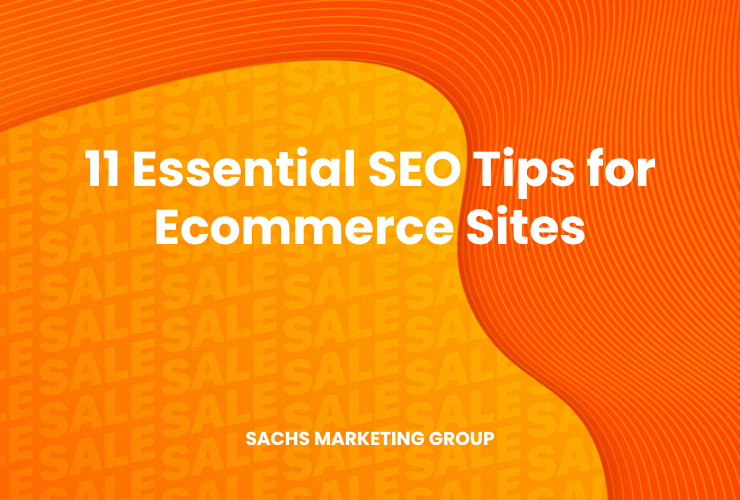Some of the most important SEO tips for ecommerce sites include providing a secure shopping environment, optimizing product pages, using structured data, and improving website speed. These strategies not only help to rank higher in search results but also improve the user experience.
Search Engine Optimization (SEO) is the backbone of any ecommerce business that wants to stand out in the crowded online marketplace.
Ignoring it could mean missing out on clicks, conversions, and ultimately sales. This can quickly take a toll on your business if you’re selling products in a competitive market.
Fortunately, incorporating SEO techniques specifically tailored for ecommerce sites can make a world of difference in your online visibility and sales.
In this article, we’ve gathered some of the most important SEO tips for ecommerce sites so you can get started.
Overview
SEO Tips for Ecommerce Sites
The battle for ecommerce visibility is fierce, with countless businesses competing for the top spots in search engine rankings.
Often, the struggle lies in not just driving traffic to your website, but in converting that traffic into actual sales. However, the good news is that with the right SEO techniques, your ecommerce site can stand out from the crowd, attract more organic traffic, and increase your sales conversions. Whether you’re a small startup or a well-established online retailer, optimizing your website for SEO is no longer optional – it’s a necessity for business growth.
Here are 11 SEO tips for ecommerce sites to help you enhance your visibility, attract a larger customer base, and drive more sales:
1. Provide A Secure Shopping Environment with HTTPS
Security is paramount in the online world, especially when transactions are involved. Shoppers are becoming increasingly cautious about where they input their personal and financial details.
This is where HTTPS (Hyper Text Transfer Protocol Secure) comes into play. HTTPS encrypts the data transferred between a user and the server, adding an extra layer of security. Not only does this enhance customer trust, but it also positively impacts your site’s SEO.
Google has confirmed that HTTPS is a ranking factor, so an SSL certificate is essential for any ecommerce website. You can purchase an SSL certificate through your web hosting service or a third-party provider.
2. Optimize Product Pages (descriptions, details, images)
Product pages are the heart and soul of any ecommerce website. They’re where the conversion happens. Therefore, it’s crucial to optimize these pages meticulously.
Descriptions: Write compelling and informative product descriptions that tell a story. Use language that resonates with your target audience and focuses on the benefits of the product, not just the features. Make use of relevant keywords but avoid keyword stuffing.
Details: Additional product details like size, color options, material, and warranty should be easily accessible and well-organized. These details can often be the tipping point for consumers who are on the fence.
Images: High-quality images are non-negotiable. According to various studies, more than 75% of online shoppers rely on product images when deciding on a potential purchase. Use multiple images from different angles and include zoom-in functionality. You should also consider incorporating videos that show the product in use, offering a more comprehensive understanding of what you’re selling.
This area of SEO is called on-page SEO, and it’s one of the foundations you can’t ignore. The on-page optimization is one of the first steps to ensure your website is optimized for your target keywords, eligible to rank competitively in search engines, and can help reduce how long it takes to rank on Google for your target keywords.
Depending on the size of your website and how many products you have, this process can be overwhelming. To help you organize your approach, we’ve created an on-page SEO checklist to help you get started.
For a quick head-start, consider using our free SEO analyzer – it will reveal the strengths and weaknesses of your on-page SEO, providing you with direction.
3. Utilize Structured Data
Structured data refers to the organization of information in a manner that makes it easily readable by search engines. When properly implemented, structured data can result in rich snippets, which are enhanced search results featuring extra information such as star ratings, product prices, or customer reviews. These rich snippets make your listing more attractive, leading to higher click-through rates (CTR) and potentially higher sales.
For ecommerce sites, structured data can include a range of details like product name, brand, price, and stock status. JSON-LD (JavaScript Object Notation for Linked Data) is the most recommended format for adding structured data to your website. Google’s Structured Data Markup Helper is an excellent tool for generating the necessary code, making the process easier for those who are not as technically inclined.
By investing time in implementing HTTPS, optimizing product pages, and utilizing structured data, you can significantly improve your ecommerce site’s performance in search engines and user experience.
Related: 10 Benefits of Ongoing SEO Services
4. Optimize URL Structure
The URL structure of your ecommerce site plays a pivotal role in SEO as well as user experience. A well-crafted URL is easy to read, describes the content accurately, and includes relevant keywords. Avoid using generic or numerical identifiers, opting instead for descriptive words that give users and search engines an idea of what to expect on the page.
For example, instead of a URL like www.yourstore.com/product/12345, use something more descriptive, such as www.yourstore.com/womens-running-shoes. Additionally, keep the URLs as concise as possible. Overly long URLs can appear spammy and may discourage clicks.
Remember also to use hyphens (-) instead of underscores (_) to separate words. This is because search engines like Google treat hyphens as space but underscores can be viewed as a character, affecting search rankings.
5. Create An Enjoyable Shopping Experience
An enjoyable shopping experience is critical in attracting and retaining customers. This means more than just having an attractive web design. The navigation must be intuitive, allowing users to find what they’re looking for with ease. Filter and sorting options should be available to aid in the search for the perfect product.
Moreover, consider adding features like a “Recently Viewed” section or personalized product recommendations based on user behavior. These elements can create a more interactive and tailored experience for the visitor, increasing both engagement and the likelihood of conversion.
Accessibility is also crucial – your ecommerce site should be easy to use for people with disabilities. Make use of alt texts for images and ensure your site is navigable through keyboard-only commands. Doing so not only broadens your customer base but can also improve SEO rankings, as search engines are increasingly considering accessibility in their algorithms.
6. Improve Website Speed
The amount of time it takes for your website to load is a significant factor for both SEO and user experience. Slow websites can be a deal-breaker in the ecommerce world – so much, in fact, even a one-second delay can result in a 7% decrease in conversions according to various studies. This is why it’s important to use tools like x or y when reviewing your technical SEO.
Start by optimizing images – they should be of high quality but also compressed for the web. Lazy loading, where images only load when they appear in the user’s viewport, can also help to speed up the initial page loading time.
Additionally, leverage browser caching and optimize your website’s code by removing unnecessary characters that are not visible to users but take up data. Use tools like Google PageSpeed Insights or GTmetrix to identify areas of improvement.
Content Delivery Networks (CDNs) can also be used to distribute the load, saving bandwidth and speeding up access for your potential customers.
Improving website speed not only results in a higher ranking on search engine result pages but also creates a smoother, more enjoyable experience for users, thereby increasing the chance of conversions.
This area of SEO can be overwhelming and rather technical, so be sure to use our helpful 10-Point Technical SEO Audit Checklist.
7. Prioritize Your Mobile Experience
In today’s digital age, a significant portion of ecommerce traffic comes from mobile devices. Prioritizing the mobile experience is not just a nice-to-have – it’s a necessity! Google’s mobile-first indexing is a testament to this, as it ranks your website based on the mobile version of the site. Therefore, ensuring your website is fully responsive and offers a seamless experience on smaller screens is crucial for SEO and user satisfaction.
One effective approach is to implement Accelerated Mobile Pages (AMP), which are designed to load quickly on mobile devices. Utilize a mobile-friendly design that features easy navigation, readable text, and a straightforward checkout process. Also, make sure all clickable elements are adequately spaced and easy to tap on a mobile screen to reduce errors and frustrations.
Test your website’s mobile compatibility regularly and pay close attention to page loading speed, visual elements, and functionalities like forms and buttons. Usability should never be compromised regardless of the device being used to access your ecommerce site.
8. Provide Clear Navigation
Clear, intuitive navigation is essential for a successful ecommerce website. The easier it is for customers to find what they’re looking for, the higher your chances of making a sale. Begin by having a well-structured menu that categorizes products logically. Incorporate a search bar at the top of every page, ensuring it’s easily accessible and provides auto-suggestions or corrections.
Breadcrumb navigation can also aid in providing context and allowing for easier navigation. This is especially beneficial in ecommerce sites that have a multitude of product categories and subcategories. For example, a breadcrumb trail for a men’s watch could look something like: Home > Men’s Accessories > Watches > Brand Name.
In addition, employ filters and sorting options that allow users to customize their viewing experience based on variables like price, popularity, and ratings. These options help streamline the search process, making it less overwhelming and more targeted.
Clear navigation not only improves user experience but can also positively impact your SEO. Search engines can better understand the structure and content of your site, potentially leading to higher rankings in search engine results pages.
By prioritizing mobile experiences and providing clear navigation, you’re laying down the foundational elements for an ecommerce site that’s geared for success both in terms of user experience and SEO.
9. Share Product Data with Google
Sharing your product data with Google can significantly amplify your ecommerce store’s visibility and reach. Different Google platforms can showcase your products, each offering distinct advantages. Here’s a breakdown of where your products can appear and the benefits of each:
- Google Search: Sharing product data with Google Search allows your products to appear in organic search results. The more relevant and optimized your product data, the higher the likelihood your product pages will rank well. This gives you the opportunity to attract free, organic traffic to your website, saving you money in advertising costs.
- Google Images: Google Images is often overlooked, but it’s an essential channel for ecommerce, especially for products that rely heavily on visual appeal. Optimized product images can appear in Google Images search results, providing another avenue for potential customers to discover your products. Always make sure your images are high quality and utilize alt text for SEO benefit.
- Google Lens: Google Lens is an image recognition technology that can identify products and offer additional information or purchasing options. By sharing your product data, you can be included in these results. This offers the potential for capturing shoppers who are in the comparison or even intent-to-buy phases of their shopping journey, creating a more direct route from browsing to buying.
- Google Shopping Tab: The Google Shopping tab is a specialized search function dedicated to products. It offers a more streamlined shopping experience for users, showcasing prices and reviews. If you share product data here, users can compare products and prices at a glance, increasing the chances of attracting cost-conscious consumers.
- Business Profile: A Google Business Profile lets you manage how your business appears on Google Search and Maps. By sharing product data here, you can provide potential customers with a snapshot of what you offer before they even visit your website. This helps you stand out from competitors and attract more local and relevant traffic. Check out our guide on 10 Google Business Profile Optimization Tips to ensure your profile is optimized.
- Google Maps: Sharing product data with Google Maps is beneficial primarily for businesses that also have physical locations. Your products can appear in local searches, directing potential customers to both your online store and your brick-and-mortar locations. This is particularly effective when optimizing your website for local search and can be a real boon for driving foot traffic.
By strategically sharing your product data across these Google platforms, you can effectively maximize your online presence, capturing interest and converting it into sales through multiple touchpoints. This integrated approach not only enhances your ecommerce site’s visibility but also creates a more dynamic and user-friendly shopping experience for potential customers.
10. Track Visibility and Sales
Monitoring your ecommerce site’s visibility and sales is crucial for evaluating the success of your SEO efforts.
Use analytics tools like Google Analytics to track key metrics such as organic traffic, conversion rates, and average order value. Additionally, pay close attention to the performance of specific keywords and how they translate into sales.
This data is essential for making informed decisions and adjustments to your SEO strategy, helping you identify what’s working and what needs improvement. Regularly tracking these metrics will provide you with actionable insights and help justify your SEO investments.
11. Hire an Ecommerce SEO Expert
Taking your ecommerce business to the next level often requires the expertise that only a dedicated SEO professional can provide.
An ecommerce SEO expert will have specialized knowledge in keyword research, site optimization, and data analysis specific to ecommerce platforms. They can also help you navigate the intricacies of algorithm changes, making sure that your site doesn’t just attract traffic but also converts visitors into customers.
Partnering with an expert will free you up to focus on other crucial aspects of your business, ensuring that your SEO is in capable hands.
Need Help with Your Ecommerce Site?
Struggling to improve your ecommerce site’s visibility and sales?
Sachs Marketing Group specializes in ecommerce SEO services designed to tackle these challenges head-on.
Imagine doubling your organic traffic, seeing your product pages rank at the top of Google, and watching your conversion rate skyrocket.
Don’t let poor SEO hold you back. Reach out to us today for a free SEO audit and see how we can tailor our services to meet your specific needs.
By leveraging the expertise of our agency, you can rest assured that every aspect of your SEO will be optimized, setting the stage for exponential growth in both visibility and revenue.
Conclusion
SEO is an essential part of running a successful ecommerce business. The tips provided in this article can help you enhance your site’s visibility, user experience, and conversion rates.
Invest the time and resources needed to optimize your ecommerce site for SEO and watch your business grow.
Contact us today to get the conversation started!













